Blog Archives
Joining Donald C. Kelly on The Sales Evangelist Podcast
I discuss what branding means for Sales teams, chat about Tide’s big Superbowl win and the idea of Radical Transparency.
CATEGORIES:
De-mystifying branding on Nick Westergaard’s On Brand Podcast
A passionate discussion on why I declare branding having substituted advertising and dive into my new book Bigger Than This.
CATEGORIES:
Bigger Than This
A quick read about the deceptively difficult task of turning your venture into an admired brand.
CATEGORIES:
About Bigger Than This
Video with author Fabian Geyrhalter discussing the book “Bigger Than This.”
CATEGORIES:
What Any Brand Needs To Learn From Amazon’s Physical Bookstore Experience
I just spent an hour at Amazon. Not on Amazon, at Amazon.
As an author with a second book release upon me, I study book marketing up close hence I just had to make a pilgrimage to Los Angeles’ first physical Amazon bookstore. It opened two weeks ago as part of the Westfield Century City Mall‘s universally talked about staggering 1$ Billion re-model (…and we thought retail was dead).

I was doubtful when I initially heard about Amazon going into physical storefronts thereby going back to the business model they once so successfully disrupted many years ago. Well, my doubt was quickly turned into exhilaration as Amazon did not simply open a storefront, they changed the way consumers experience products offline – with a whole lot of help from online insights.
Amazon successfully and holistically transformed what worked online into a physical brand experience. It took full advantage of its massive amounts of data, to my delight. At the AmazonBooks store, you are greeted with shelves titled ‘Highly Rated – 4.8 Stars & Above’ or ‘100 Books to Read in a Lifetime – Our Picks from the Amazon.com List.’ Not surprisingly, it works and it pulls you into a curated, and more importantly, customer-verified, experience. Do you trust that Maggie from the local bookstore has a ‘Staff Pick’ or do you trust hundreds, thousands, millions of readers just like yourself? Sorry, Maggie, I am all up for supporting local stores, but that was an easy pick.

Not so quick though, as Amazon knows it needs to, and should, make the experience a local one. ‘Read Local – Notable and Highly Rated Los Angeles Books’ as well as top-rated books from readers in L.A. are showcased prominently. Another nice touch is Amazon’s integration with the online reader community of Goodreads, albeit logical as Amazon acquired the site in 2013. Still, seeing ‘Goodreads Most-Read Classics’ and ‘Book Club Picks from Goodreads’ adds more intrigue to the books stacked in traditional bookstore style underneath. Each of these components engages, builds trust, and keeps you in the store longer.
But let’s not paint a picture of Amazon showcasing only the proven books, by the biggest authors, on their rather limited shelf-space. You’ll see books of unknown authors, some that are rated only a few times, next to the big sellers. One book particularly stood out (Innovating by Luis Perez-Breva and Nick Fuhrer) as Amazon’s description reads ‘100% of reviewers rated this item 5 stars.’ The book only had 21 reviews in total. This makes me feel like I am discovering something, which is one of the key ingredients of a great book store.
Amazon also picks customer reviews to showcase, rather than the author’s book description, or an Amazon editorial review, which makes the experience even more personable.
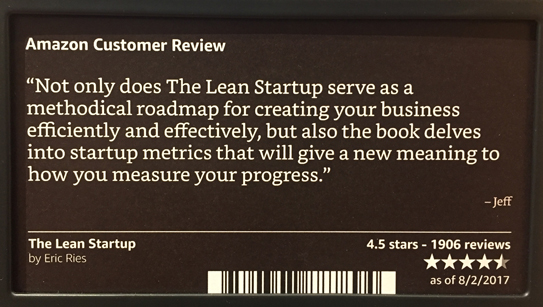
The last store curation effort that made my heart speed up was the huge shelf-space dedicated to ‘If you like this, you’ll love these.’ A key component of the Amazon.com shopping experience, seeing a book you liked on a shelf with six you never heard of next to them, suggesting that you’ll love them is a sure-fire win in any customer browsing experience.

Besides taking away that Amazon has nailed its data integration into its retail environment – not to anyone’s surprise – what can you, as a CMO of a brand or as a startup entrepreneur learn and immediately utilize from its success?
Map your online customer brand experience, then take it offline.
It feels upside down, and precisely that is Amazon’s amazing ‘Zag’ in this instance. How do users behave on your site, what content do they read, what call-to-actions do they skip, which offerings do they spend the most time on, and so on and so forth. Study it. It’s there, you just have to start digging into it.
Then take that data and make use of it in all the ways you conduct business offline. As many of you don’t have retail stores that you can start experimenting with, you may think this is not applicable to your brand. Think again: sales presentations, prospect case study conversations, tradeshow experience designs, new product launch considerations, brand initiative ideas, brand narrative adjustments – you name it. That online journey can be a game-changer in the way you engage with your customer/consumer/member everywhere else.
Much has been said about leveraging latent data and creating actionable new data points for brands of all sizes to utilize, but the essence of what Amazon did is actually rather simple at heart: Study the trail your online users leave behind and use it to educate a new or revised, deeply educated and highly personalized offline brand experience.
What we learn from AmazonBooks is that these insights can even be used to craft a brand narrative for a new brand extension: Translating what works naturally online (‘if you like this – you may like that‘ as an example) for their brand and making it work as a novelty in an offline experience that is 100% true to Amazon’s brand essence. It’s not just connecting data for increased sales, it is doing so in a way that is intrinsically true to the core brand philosophy.
Amazon’s user journeys helped create an offline sub-brand. It may be time to look at your brand’s online data, create your user journeys and translate them into successful offline experiences. It will re-affirm, or re-educate your brand’s essence, or perhaps it will even inspire you to launch a new brand extension.
Until then, you can find me at Amazon as on Amazon is just too one-dimensional and old-fashioned.
How To Share Your Brand’s Offering – Brilliant Brand Messaging Lessons From Acorns And Emojis
I entered a contest. Not a design competition, but a simple consumer contest.
And that matters because, really, who enters contests? We are all busy people. Especially a man in his early 40’s who is not bootstrapping his life, especially not aiming for a $20 gift card.* Well, I did, and here is why: While procrastinating – it happens to the best of us – in-between important and time-sensitive client workshop preparation tasks, the following E-Mail popped up in my ‘Everything Else’ area of my Inbox (yes, it accurately landed on the opposite side of my ‘Important’ E-Mails):
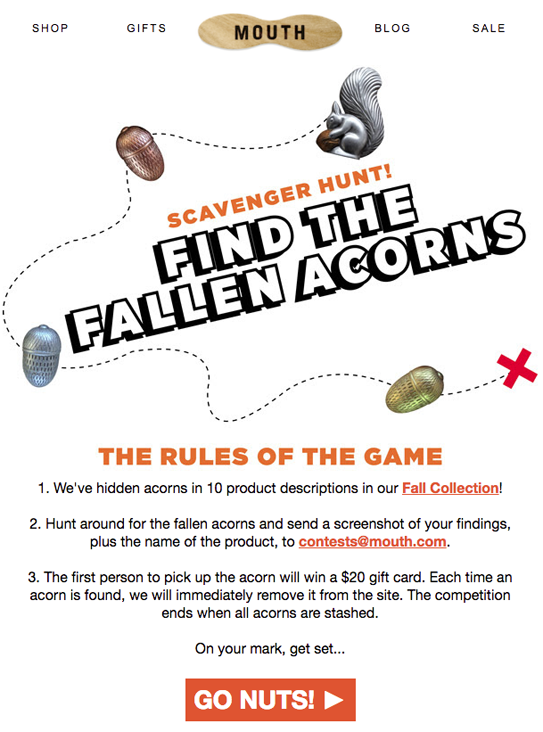
They got me with the squirrel.
And the time-sensitive part.
So, nuts I went.
I went nuts not to find that silly acorn, well that too, but over the genius, or the team of geniuses, who were briefed to get people to click-through their Fall Collection of indie food products. Instead of a beautiful collage of their products, or by cramming in as many different products as they can, they created a ‘fallen acorns scavenger hunt’ thereby ensuring people had to click through a lot of their new products thereby familiarizing themselves with a variety of offerings not unlike they would scrolling through an Instagram feed.
I did click on one product (‘brand research – had to make sure it worked before I wrote about it’) and saw an acorn. That’s when my brain switched from ‘marketing technique intrigue’ straight to ‘happy acorns hunt participant.’
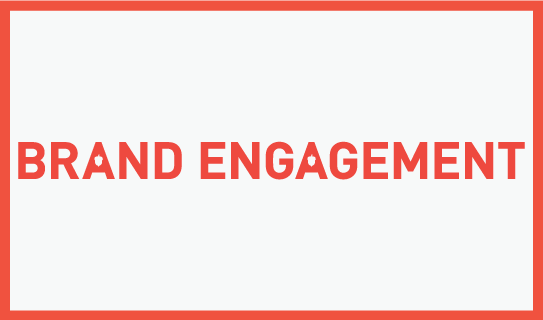
If you can get the E-Mail recipient who is the least-likely to partake in a contest, even less likely to engage in reviewing products he is not interested in purchasing at the time (but will likely recall once the holidays are rolling around) to click through your E-Mail and participate in your brand in the middle of a workday, you clearly did something very right.
Back in July, the San Francisco Museum of Modern Art (SFMOMA) launched their way of successfully distracting people from their work by asking them to text them an emoji. The service sends a related art piece of their vast collection in return of you texting ‘send me [insert any emoji, keyword or color of choice]’ to their number (572-51, if you are curious).
Here was my wife’s interaction at the time. I immediately tried it myself.
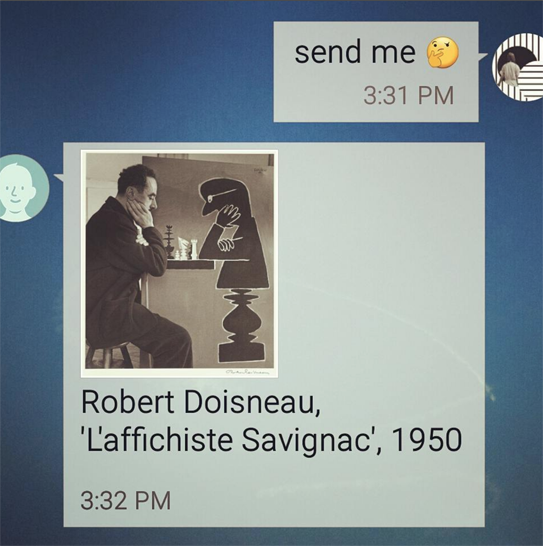
Intrigued? Of course.
You are not alone. In one single week they received – hold your breath – 2 million texts of people hungry to see art that was relevant to their current mood or personal interest. For the museum, it was an answer to the question ‘How do we get people to see all the art (95% of the collection) we simply can not show on the floors of our museum?’ What they got in return was so much more than interest in art. They created brand awareness, and brand love, (and collected millions of phone numbers) via a simple idea and an auto-reply powered by good data.
It’s time for us to gamify our brand experiences, especially the ones that are being sent via E-Mail to thousands of opted-in customers like it was the case in MOUTH’s acorn hunt example. E-mail has a median return on investment (ROI) of 122% – more than four times higher than other marketing formats, including social media, direct mail, and paid search. Combine that with an audience of hungry, active users that are ready to act, and yet you plug out one templated E-Mail promoting your product after another.
Stop.
Sit back and think about why the recipient would take action.
- Is it a question you provide a ‘must-know’ answer to?
- Is it an ‘act-now’ (and now only) deal?
- Is it a unique gamified experience?
- Is it triggering intrigue, or a feeling of exclusivity, that causes actions?
Send less. Think more. Gain real engagement.
Take a step back from your analytics tools, grab a few fellow team members, a conference room, and a highlighter and take over the good old whiteboard. Your ROI will soar and your brand will thank you for not being a spam brand, but an engaging brand.
Let’s thank a bunch of acorns and emojis for that.
*Side note to that acorns hunt E-Mail example: Getting a $20 gift card for a minimum $100 order, so a 20% Off Your Next Order ‘gift’ is a rather sad incentive (why not truly give $20 gift cards?) that can quickly turn potential fan excitement to immediate bummer brand reclusive. I noticed that after my hunt was over.
Joining Jay Baer’s Convince & Convert Influence Pros Podcast
We discuss why it’s key to know your core values before hiring an influencer and how to come up with actionable values.
CATEGORIES:
Joining Business Rockstars to dive into startup naming
Jump to 1:13 to get 10 minutes of my biggest tips for creating a name for a new company.
CATEGORIES:
How To Launch A Brand: Lose The Ego, Gain A Soul
This interview with Fabian Geyrhalter, Principal of FINIEN, was originally published in The Huffington Post 07/15/16.
Chances are, if you’re a startup or a small business, at some point you’ve asked yourself: “How do I effectively launch my brand?”
While there are quite literally hundreds if not thousands of ways to get the word out these days, the truth is, unless you have a solid foundation from which to launch, your company could very well end up face-down on the pavement. In other words, if your brand lacks the necessary qualities to attract and retain loyal customers you may need to rethink your strategy.
As someone who constantly thinks about these things, I thought it would be fun to sit down with my friend and branding-savant, Fabian Geyrhalter, Founder and Principal of FINIEN. His Los Angeles-based consultancy specializes in turning ventures into booming brands. I’ve had a front row seat to his genius over the last few years, and watched brands he’s advised go from “zero to hero” in a very short period of time. Some have become market leaders, while others have sold to huge companies. Although his branding prowess wasn’t the only factor in these successes, I have no doubt it played an important role.
So whether you’re looking to refresh a brand you dreamt up three years ago or are starting from scratch without a website your business can call home, listen closely to what Fabian G. has to say. Here, I pick his brain on all things branding, positioning, and what you need to be successful in today’s digital world.
P.S. – He recently released the second edition of “How to Launch a Brand”, a step-by-step guide to crafting a brand, from positioning to naming and brand identity. It’s, pretty much, a must-read for anyone developing their own brand (which is basically everyone when you think about it, given how personal branding plays into individual’s professional careers today).
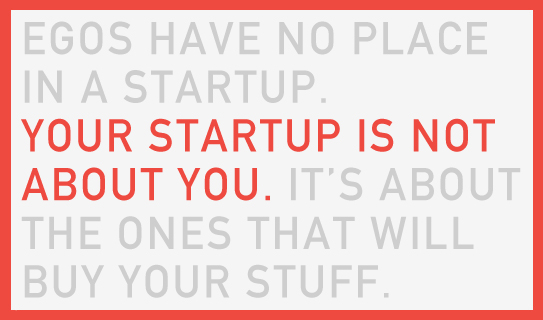
Rebekah Iliff: How many startup brands/companies have you worked with over the last several years?
Fabian Geyrhalter: In the last 3 years perhaps 50, in different capacities. The diversity in the brands we help launch is really what gets me up in the morning and why I dedicate my professional life to doing what I am doing. We helped craft a croatian underwear brand, a workers comp insurance disruptor, a VR brand, a winery, and then of course the expected fair share of apps.
What is most exciting is getting our heads into the minds of these highly diverse consumers and users and diving into the soul of these brands and connecting the two. Most founders are too close to their product, they built a tall wall between themselves and their product and the other side, the one that is so important, the consumer. It is usually mainly psychological – they have not moved an inch from their screens, so they are a bit disconnected from the ones using the product. I talked to a tech startup that worked on a product for moms and their toddlers. I asked them how much time they spent having coffee with moms or playing with toddlers. I received a deer in the headlights stare back. It was awkward; mainly for them.
RI: Why is it important for companies to think of their brands as having a Soul?
FG: A product that competes on price and features alone can never become a brand. A company that has soul does not need to compete on price; ever. Soul is what connects a product or service to a human’s emotion; a soul searches for a soul. We buy Patagonia and TOMS for a reason, and it’s not because of their product.
RI: What other brands do you think have a soul and why?
FG: Yes, there are the Patagonias and TOMS, but there are many startup brands that do it very well also. One I love to cite is Shinola. Born out of necessity and belief, the brand is fueled by authenticity and it found a great voice for itself that directly sparks emotion with their audience. I just spent $280 on a Shinola wallet last week. I did not think once of cross-comparison shopping. It just felt right. It was an all-brand purchase, solely emotional.
When that happens with a very young brand, then you know someone’s done their homework upfront when crafting a brand.
Another example would be Topgolf who realized that if they focus deeply on the target audience they would find the holy grail to generate revenue as a golf startup in a landscape where golf is known to be on the way out, not being able to connect with millennials. Topgolf created spaces to hang out, guys have craft beer and watch the games, ladies can wear high heels and sip cosmos, and everyone can enjoy instagram-happy lighting – and golf is something that happens in the background. They must have looked at bowling and realized that it’s a perfect recipe to get kids to start liking an ‘old’ sport again. It’s about them – and about socializing, in a way that works particularly well for that new audience. That is soul: soul searching in order for souls to connect.
RI: There has been a shift to brands focusing on “Purpose.” What’s the easiest way to incorporate Purpose into your brand, even if you’re a young company?
FG: The easiest way is to look at what your brand stands for, what is the WHY behind your brand: Why does it matter to have this product in this world at this point in time and for the long term and why will your audience deeply care? There is an intersection that will point towards a social cause that can be utilized in an authentic way to manifest that the purpose of the product/service goes deeper than generating sales. That is the easiest way since you asked for that; one that over the past 5 years has become somewhat of a staple for startups founded by millennials as ‘purpose’ is already ingrained in their thinking: “We don’t work for money alone, money is a necessity but not the reason why we are going into the workforce.” Multiply that by ten when they start a business on their own where the sky’s the limit, and the true north is up to their imagination.
In times of great political fear and danger, this generation of entrepreneurs is a shining star on the horizon, and I am grateful to be able to spend my days working with inspired, soulful people like that.
RI: In your book, you talk about Brands that have successfully made people an important part of their strategy. What is the advantage of doing this, over simply having a brand like Coca-Cola without a person attached to it.
FG: It’s a very strategic move that I discuss in my initial workshop with founders: How far do you want to, need to, or should you be the brand as a person? There is a clear danger to have a person be too closely tied to a brand, as was the case with American Apparel when things go sour, or it could simply hinder a smooth exit strategy. Most often founders are deeply tied with their brands.
The extreme is a Richard Branson, but on the other side of the spectrum you have a John Mackey (of Whole Foods), who only people in the business community know, despite him being the brand as a person. Ultimately, you can be the brand as a person in different ways. Many of my clients have several people that speak on behalf of the company. One faces the public as the creative force, the other as the business force, etc.
Rule of thumb is don’t name your business after yourself and don’t promote yourself more than your product, unless you are a consultant and you defacto are your business.
Even when I talked to a young and rising fashion designer I advised her to steer away from using her name and amplifying her image as part of the brand, even though we all know she is the sole designer. More often than not it causes brand turmoil down the line and is sparked mainly by ego, and believe it or not, egos have no place in a startup. Your startup is not about you, it’s about them – the ones that will buy your stuff. Think of them, think like them, don’t think about yourself.
RI: Why do you think so many early stage companies skip the Brand aspect of the process?
FG: One part lack of knowledge and understanding, one part negligence. Shake it in a speed-to-market way and top it off with self-funding and you have the Anti-Branding cocktail. It has a bitter after taste, guaranteed.
And this really is the reason why I wrote “How to Launch a Brand”. I wanted to create awareness and provide a step-by-step process. Affordability is not money alone, it’s also time. They can take an hour and a half and read the book and be aware and educated, or take a day and work through the workbook edition and get a lot of the important brand thinking done themselves. Some things they can do for themselves, some things (like creating the logo) they should leave to professionals, but even if they just listen to the 2.5 hours of the audiobook, at least they have a great understanding of the process and of the issues that can occur, steps not to miss and what to do at what time in the process.
I tell tech startups that branding is the first feature to which their audience will ever be exposed. That usually is a wake-up call.
RI: What do you think is a fair investment in terms of what an early-stage company should be spending on branding? For a resource-constrained startup, what makes sense?
FG: Early stage is such a loose term in this soon-to-come-bubble, but if they are working on a startup that they know they will invest a few years into and they will launch in a serious manner, they have to put aside a marketing budget and 40k should be the minimum to be allocated to crafting a meaningful brand strategy, name, voice and overall identity. For bootstrapped startups it can now be cut to $34.95 for the workbook I just released. Wink wink.
RI: Can you measure the ROI of a well-developed Brand?
FG: If six months after launch you have loyal followers, you have a tribe that posts for you in social media, that wears your pins and sports your logo, then you can definitely say that the investment into branding was well worth it. If you land a major investment because of the story and the professional deck and the amazing design from the inside (app/product) out (logo/site), then you should allocate a fair share to branding as well.
If your brand goes viral six days after launch because your name offends an entire country, people talk more about how weird your logo is than about your actual offering and if the few people within your target group, whom you force to look at your site don’t get what you do and why they should connect to it at all, then you most likely should point a finger (a specific finger) towards the brand folks.
Fabian Geyrhalter Speaker Reel 2016
Examples of Fabian Geyrhalter speaking about branding, specifically for new ventures.
CATEGORIES:



